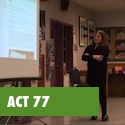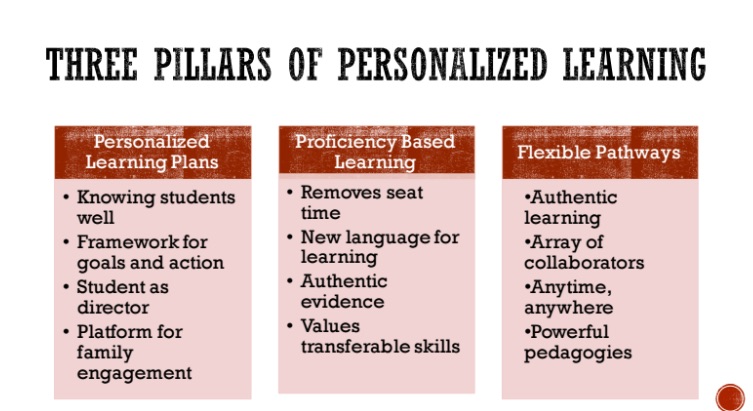Taking stock on implementing Vermont’s Act 77
 “Do you know where you are?”
“Do you know where you are?”
Usually it’s a question medical professionals ask in emergency situations. It’s not as dramatic in the context of education, but it can be just as useful as a diagnostic criteria.
We’re going to ask you to take stock of where you are in the implementation of three pillars: Personalization (PLP’s), Proficiency, and Flexible Pathways. They’re the three pillars holding up Act 77, Vermont’s legislation to put students at the center of innovative school change.
whips out a clipboard, tucks pen behind ear
Ready?
Just like when it comes to proficiency-based learning for students, schools need to have clearly defined targets, evidence of progressions, and reflections about the work that indicate next steps in the process.
That’s the whole point of taking stock of where you are: so you can know where to go next.

For each of the three pillars of personalized learning, we’re going to give you some statements to reflect on, and ask you to work through the statements, thinking about:
- Challenges
- Successes
- Evidence
- Next steps
We’ve pulled together a set of handy worksheets for this exercise. You can:
- open up the .pdf worksheet in another tab;
- download all three here as a zipped file of your choice of .pdfs or Word .docs
Why three pillars for personalization?

In an recent article called Getting Personalization Right: How Personalized Learning is Working in Vermont, authors Penny Bishop, John Downes and James Nagle present a solid argument for three pillars for personalized learning to be pursued in parallel.
The opportunity here is to see these pillars as how one aspect might inform another, resulting in truly equitable and highly engaging outcomes.
Pillar 1: Personalized Learning Plans (PLPs)
What have you tried? How did it work? Could something else work better?
One way schools work towards increasing personalization is by paying attention to Personalized Learning Plans (PLPs).
A PLP is a plan developed on behalf of a student by the student, a representative of the school, and the student’s parents or legal guardian. It needs to be developmentally appropriate and reflect the student’s emerging abilities, aspirations, interests and dispositions.
Where are you on PLPs? Use these questions to take stock:
- PLPs are currently being implemented in my school.
- These PLPs are owned and driven by the students.
- And they include participation by families or other interested parties.
- Student goals and aspirations are valued in the PLPs.
- The PLP process has been shared with the community; understanding and support are being collaboratively built.
- Professional development is currently in place to support PLPs.
Again, using the worksheets, take time for yourself, or with your team to work through each of these questions, looking at the Challenges, Successes, Evidence and Next Steps.
Pillar 2: Flexible Pathways
Flexible Pathways as defined by Vermont’s Proficiency-Based Learning Glossary:
“Any combination of high-quality expanded learning opportunities, including academic and experiential components, which build and assess attainment of identified proficiencies and lead to secondary school completion, civic engagement, and postsecondary readiness. Flexible pathways allow students to apply their knowledge and skills to tasks of personal interest as part of the personalized learning planning process.”
In essence, the question we are trying to answer is: are we creating more than one way for students to learn and demonstrate their growth?
Ask yourself how true the following statements are for Flexible Pathways in your school:
- The learning identified in the flexible pathways has a way to be honored or awarded “credit” that counts towards graduation requirements, including learning that happens over the summer.
- Community partnerships are currently sought and developed.
- Professional Development is currently in place to support the development of flexible pathways and curriculum design
- The flexible pathways process has been shared with the community and common understanding and support are collaboratively being built.
Pillar 3: Proficiency-Based Learning
Finally, let’s look at the qualities necessary for rigorous, student-centered Proficiency-Based Learning/Assessment as outlined in the video below.
5 statements for reflection:
- Our proficiency-based learning system includes:
- Clear expectations of learning
- Student progress measured and supported
- PLPs and Flexible Pathways that lead to Proficiency-Based Graduation Requirements (PBGR)
- The system reflects transferable skills throughout.
- Students progress based on proficiency, not seat time.
- Appropriate reporting systems are in place to help students, parents, and teachers understand the progress of learning.
- The proficiency-based process has been shared with the community; common understanding and support are collaboratively being built.
So what’s the big takeaway here?
If you (as an individual, team, school or community) take the time to think about where you are in this process, you’ll understand if your efforts are having the desired outcomes. This will help provide a framework for your thinking and ultimately, inform the next step for you or your school.
Additionally, we hope you will continue to grow, learn, and share this process, or the one you use, with your students and communities.


One Reply to “Do you know where you are?”
Comments are closed.